Principles of Corporate Finance Questions
(1) Note
|
| The position in the Principles of Corporate Finance textbook
by Richard A. Brealey and Stewart C. Myers is that IRR is inferior. My position in
the working paper Internal Rate of Return Revisited is that NPV and IRR have
essentially equivalent utility--that IRR is not inferior. This paper addresses an
NPV/IRR disagreement only. It is neither a book review nor a critique of any other
aspect of Principles. |
Introduction
My position in the working paper Internal Rate of Return Revisited(2) differs from that in the Principles of Corporate
Finance(3) textbook by Richard A. Brealey and
Stewart C. Myers. Questions (polite challenges) have been posed the most times in a
Brealey and Myers (B&M) context. This paper addresses those questions,
illustrated with spreadsheets
from the Olin School of Business.(4)
Net Present Value Rule
The NPV Rule is sound. It is the value of a cash flow stream with the time value of
money incorporated. IRR (Internal Rate of Return) is equally sound and easily
calculated. The purple and teal markups are my additions
to the spreadsheets. The Excel IRR function assumes reinvestment at the
IRR. The MIRR (Modified IRR) function assumes reinvestment at the
discount rate.
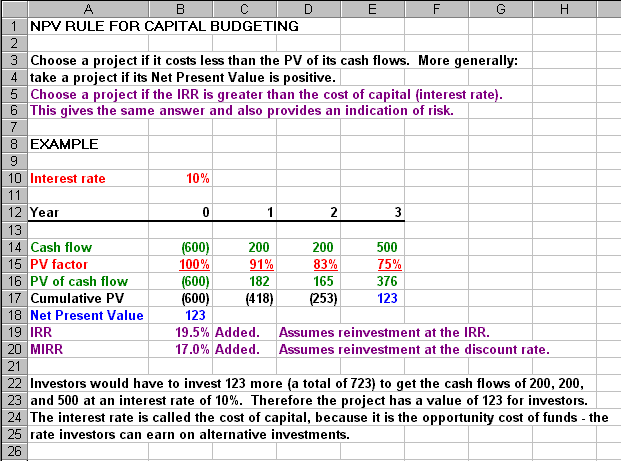 .
.
Internal Rate of Return Rule
Three issues or problems are cited by the Olin School from B&M. Commonly
though, the first two and sometimes others are incorporated into a single
demonstration. This is unnecessarily confusing. Separately they are
understandable and manageable.
- We usually keep track of lender or borrower outside the actual calculations.
Interest rate tables do not differentiate between them, but it is safe to assume the
borrower will pay interest and the lender receive it. Why should we expect more from
discounting?
- The first positive IRR is relevant. The second is useful for identifying an upper
limit for a meaningful discount rates and NPVs. When IRR is incalculable as it
sometimes is, NPV is suspect as well and may be nonsensical.
- Larger projects should be expected to have higher NPVs. IRR is useful with
different sized projects, those with different economic lives and those that begin at
other than the base year. This difficulty is easily resolved by using incremental
cash flows.
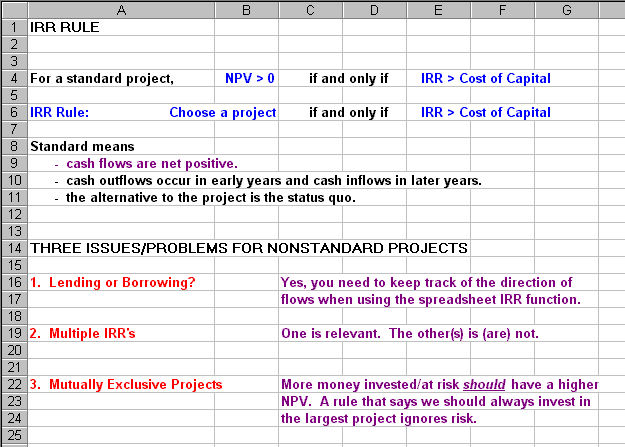
Multiple IRRs
Mixing borrower or lender with multiple rates of return is a common practice not limited
to B&M. It is unnecessarily confusing:
- Mixing obscures the fact that the 12 percent cost of capital is higher than the the
relevant IRR. The discount rate is in the nonsense zone where NPV increases with
increasing discount rates. This implies increasing value with increasing cost. It is
absurd.
- Cash flows here are net negative, though the total is excluded. No amount of
rational discounting can make them positive. If there is something to be analyzed
here, it is for whomever cash flows are net positive--on the other side of the
transaction.
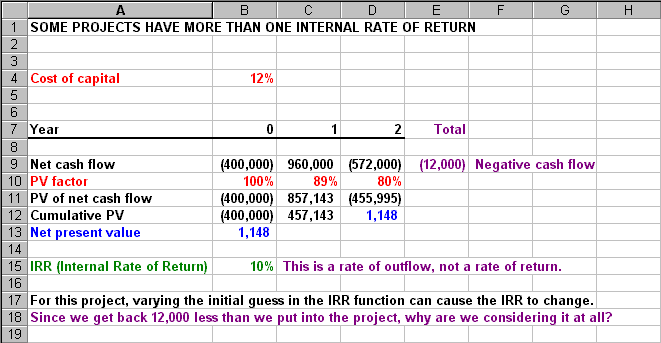
Multiple IRR Plots
Column B reflects discount rates and NPVs as presented, plotted in the top
graph. The 12 percent discount rate is in a nonsense zone where NPV increases
with it. In this example, we should attempt to increase our cost of capital toward
19 percent, since doing so will increase NPV.
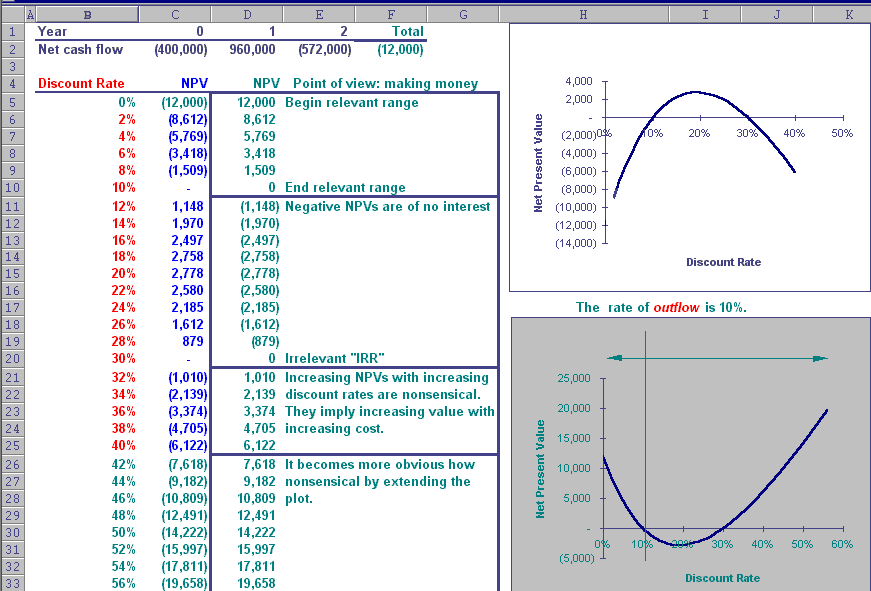
The rearranged bottom plot, viewed from the other side of the transaction, is less
confusing. The relevant range is defined by NPV at a zero discount rate to the
relevant IRR where NPV is zero. The 12 percent discount rate and other rates in the
range 10-30 percent are of no interest or are nonsensical from this side of the
transaction as well, since NPV is negative at all discount rates. Beyond a 30
percent discount rate, we enter an extended nonsense zone where NPV continues to increase
with the discount rate. The combined implications of both plots, are to increase
shareholder wealth we should:
- maximize our cost of capital past 30 percent,
- look for projects with convoluted cash flows like this one, and
- figure out how to be on the side of the transaction where cash flows are net positive.
Incremental Cash Flows
Incremental NPV is recommended by B&M. Incremental IRR is equally useful.
There is no NPV/IRR conflict. IRR is calculable on public sector projects
using incremental cash flows.
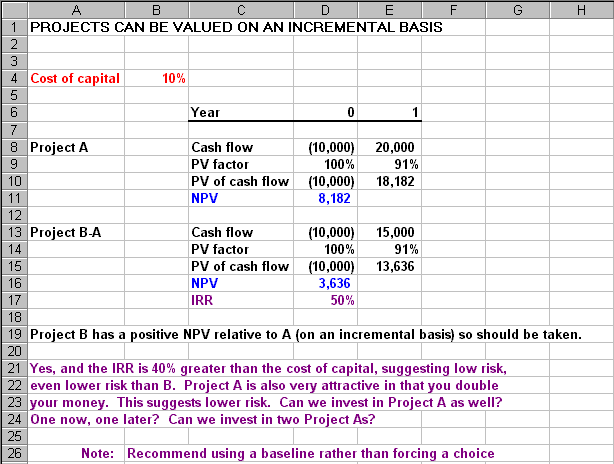
Mutually Exclusive Projects (5)
Equal risk is assumed in "mutually exclusive (different sized)" projects, but
ceteris paribus it is not. Financial risk is higher with Project B, i.e., more money
is at risk. Further, larger projects usually have more tasks, more things to go
wrong, than smaller ones. Both projects are attractive, with the key tradeoffs
between risk and return. Risk is covered in another chapter in B&M, but risk and
return are inseparable for decision making.
B&M are not necessarily "wrong."(6)
If you work at it sufficiently, you can construct a restrictive scenario where Project B
is the only choice and is really best.(7)
This simply means that more money is better than less, even when discounted. But
focusing on this fact misdirects attention from other important
considerations. More realistic scenarios suggest several opportunities.
Two are:
- Execute one now, one later. The sequence should probably be Project A first, then
B. In addition to having lower risk, Project A generates cash to finance the larger
Project B.
- Execute Project A twice. This normalizes Project A to Project B, with two Project
As the better choice than one B. Executing the same project twice or more should
reduce risk since learning from the first execution is applicable to subsequent ones.(8)
Regardless, financial analysts should be able to accommodate any apparent
contradictions rather than ignore them or dismiss IRR because it can be troublesome.
There are no contradictions between NPV and IRR in these examples. Rather they
highlight the need for both. The two measures complement each other.
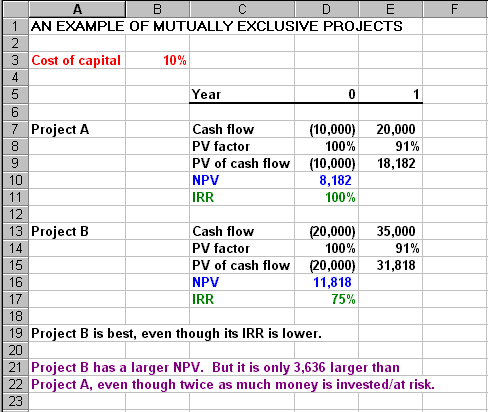
Brealey & Myers Template
This B&M template is quite useful and available from the Olin School Corporate Finance Spreadsheets.
The template is more useful with the IRR and MIRR calculations. If funds are to be
reinvested at the IRR, use the IRR function. If funds are to be reinvested at the
cost of capital and not the IRR, then use the MIRR function.

If the latter is the correct assumption, this may not be an attractive
project. At 24.3 percent (not shown), MIRR it is only 4.3 percent above the discount
rate. This suggests it is somewhat risky. Even small changes in the cash
flows, especially in early years, could drive IRR and MIRR below the discount rate and NPV
negative. For example, a tax rate increase from 34 percent to 52.9 percent starting
in Year 2 drives NPV to 0 and IRR/MIRR to the discount rate. The risk of a tax
change is, for the most part, outside the control of the firm.
Conclusion
In my opinion Brealey and Myers:
- overemphasize NPV, while unnecessarily excluding IRR;
- overstate minor difficulties with IRR while ignoring the coexistent difficulties with
NPV;
- assume unrealistically equivalent risk for different sized projects;
- overemphasize the easy-to-quantify aspects of capital budgeting decision-making;
- under emphasize the more difficult-to-quantify aspects, especially risk; and
- fail to prepare financial analysts for challenges that will invariably arise as a
result.(9)
Notes
- This working paper was done in Netscape Composer 4.0 for my use
in responding to E-mail. It uses a mix of fixed and proportional fonts plus font
colors and styles. Other browsers may not present the way it was originated. If you
have trouble reading this page, contact me,
Ray_Martin@AltaVista.net, and I will E-mail the graphics and text to you. The most
current versions of relevant papers and the Olin School of Business spreadsheets are
available from the menu at URL: https://members.tripod.com/~Ray_Martin/RMenu.html.
- Internal Rate of Return Revisited at takes the
position that NPV and IRR have essentially equivalent utility and that IRR is not inferior
to NPV.
- Richard. A. Brealey and Stewart C. Myers, Principles of
Corporate Finance, 5th edition, Irwin-McGraw-Hill, 1996. "Brealey and
Myers" is used extensively in corporate finance. It was in approximately the
3rd edition when I was introduced to it. The authors present IRR as inferior to NPV
for capital budgeting.
- This paper is out of context and will be difficult to
understand unless you are familiar with references 2. and 3 above. The Excel
spreadsheet screen captures are from Corporate Finance Spreadsheets,
http://www.wuolin.wustl.edu/faculty/back/general.htm,
at the Olin School of Business. Using the Olin spreadsheets is for convenience in
that address all the B&M questions posed to date. None of the questions came
from the Olin School of Business or any member of the faculty or student body.
- Annual cash flows with and end-of-year discounting is a poor
assumption in this problem for other than illustration. Monthly cash flows would be
more appropriate. End-of-month discounting is appropriate if that is when cash is
paid and received.
- Questions are often posed in terms of right and wrong. I
prefer relevant and irrelevant (for the intended purpose).
- Identical economic lives for greatly different sized
(mutually exclusive) projects is another strained assumption. Larger projects take
longer and have more tasks, ceteris paribus. The cumulative risk of more tasks is
likewise greater.
- "Learning curve" theory explains why, though it
primarily applies to production. Typically cost go down and schedules shorten on
subsequent executions of a project as well.
- Visualize a young financial analyst trying to explain the Multiple IRR problem above to a panel of senior decision
makers. A favorite sanity check at such reviews is to add the numbers. This
analysts is going to have to try to convince a senior group that a project in which they
will receive $12,000 less than they invest is a smart thing to do because "NPV"
at $1,184 is the largest one. Fortunately such convoluted cash flows rarely, if
ever, occur in practice.

Access Since August 10,
1998: 
 .
.  .
. 




